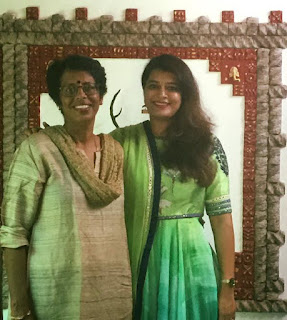Story of my first experiments in gardening
Two years back, when we went to our new home, we stressed on
our builder to keep a garden for the apartment. Due to too many reasons, the
builder refused. So I decided that I will keep my balcony green. Hence I
started growing some plants like the ‘money’ plant and few crotons. Later
necessity became the mother of invention – because my kid was catching frequent
cold and cough, I started growing Karpooravalli (Oregano), botanically known as
Coleus amboinicus, and Tulsi (holy basil) plants. I even tried to grow
chillies, however only the plant grew, there was no yield.
This way I finally decided that I will grow only leafy
plants from now on – no vegetable plants. The result is I have grown Palak
(Spinachia oleracea) – seeds purchased from Lalbagh, Bangalore; Methi leaves
(fenugreek) – seeds taken from kitchen. Believe it or not – it worked. The
plants started growing and I could make enough of palak or methi once in a
while. This really motivated me to do further. I gave some more thought.
We are a family of 3 – we two and ours one. During weekdays,
we cook breakfast and dinner. However lunch is either at office/school. With
this kind of set up, any stocking of vegetables goes waste or we end up eating
stuff that is not so fresh. Most of the times my coriander leaves or pudina or
greens goes waste. Therefore I thought why not use these in ‘pluck and cook’
mode. The solution would be to plant whichever veggies can be used in this mode
– chillies, lemon, curry leaves, coriander leaves etc. rest other vegetables
are used in larger quantity usually and hence not wasted.
So I started with chilly. This time I was more careful – I
joined the Organic Terrace gardening page on facebook and started getting more ideas. This
page is also highly motivating. After enough of research, I came to know the
mistake that I did last time – growing too many plants in a single pot. This
can work for greens, but not for others. So as per suggestions from friends, I
transplanted the chilly plant after first two leaves sprouted into a separate
pot. And it worked – we have not purchased chillies last three weeks.
Additionally started growing curry leaves also (purchased
pot). So purchase of curry leaves stopped completely unless required in bulk.
Now I have Ponnanganti (Alternanthera sessilis) planting
stems after first purchase, coriander (seeds from kitchen) in my garden – these
two are not fully sufficient, but enough for once-a-week dish with any of them.
Recently I learnt the right quantity of soil mix for growing
greens: 40% Coco peat, 40% compost, 20% soil and bit of neem cake powder. These can be purchased from
nurseries, but compost can be made at home using the vegetable waste and food
waste.
I have tried to grow palak in this proportion and it works!
Now my next experiment for growing greens in bulk starts. I will keep you
posted with my success story.
“The single greatest lesson the garden teaches is that our
relationship to the planet need not be zero-sum, and that as long as the sun
still shines and people still can plan and plant, think and do, we can, if we
bother to try, find ways to provide for ourselves without diminishing the
world. ” ― Michael Pollan, The Omnivore's
Dilemma: A Natural History of Four Meals
“The first supermarket supposedly appeared on the American
landscape in 1946. That is not very long ago. Until then, where was all the
food? Dear folks, the food was in homes, gardens, local fields, and forests. It
was near kitchens, near tables, near bedsides. It was in the pantry, the
cellar, the backyard.” ― Joel Salatin
HAPPY GARDENING!!!



Comments
Post a Comment